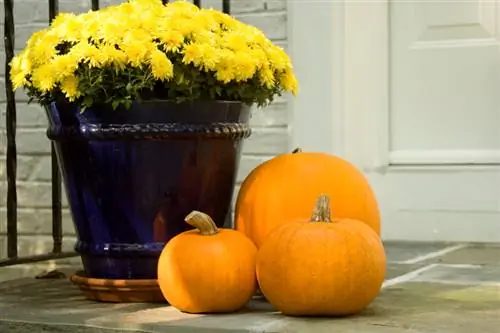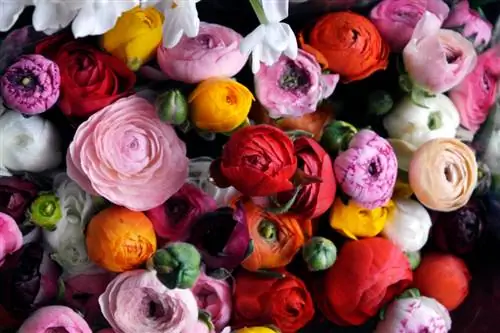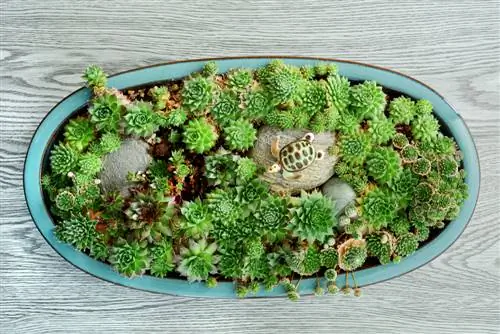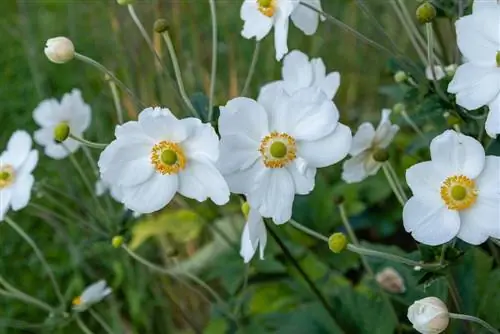- Author admin [email protected].
- Public 2023-12-16 16:46.
- Last modified 2025-06-01 06:02.
Sunny yellow, cornflower blue and a strong orange red: The cheerful flower colors of so-called decorative drugs make tea blends and dishes more appealing to the eye - after all, you eat and drink with them. You can find out which plants are suitable and how to use decorative drugs correctly in this article.
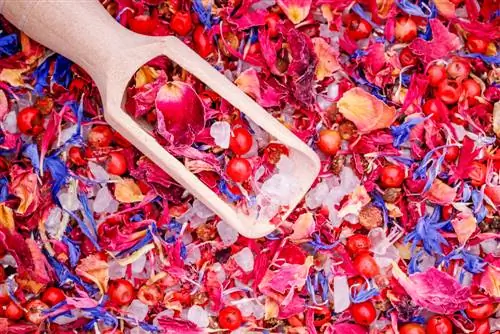
What are jewelry drugs and what are they used for?
Decorative drugs are pharmaceutically non-effective, visually pleasing plant components that make tea blends and dishes more appealing. Popular decorative drugs are edible, colorful flowers such as St. John's wort, chamomile, cornflower or marigold, which retain their color even after drying.
- Decorative drugs are pharmaceutically ineffective but visually pleasing plant components in food.
- Mostly colorful petals are used, which retain their color even after drying.
- It is important to only use edible and untreated plants.
- In addition to tea blends, decorative drugs are also suitable for flower sugar, flower s alt, salads and desserts.
What are jewelry drugs?
If you've never heard of jewelry drugs before, you'll probably cringe at first. After all, the word “drugs” sounds pretty dangerous. But in this context, this does not mean intoxicating substances that cloud the senses, because from a pharmaceutical point of view, all substances that have some kind of effect on the body and soul are referred to as “drugs”.
This also includes everyday products such as tea, coffee or sugar - and is also reflected in the use of the word "drugstore" for a shop that primarily sells cleaning products and care products. Decorative drugs are decorative substances that usually make tea blends or dishes more visually appealing. In addition to tea blends, decorative drugs often decorate these foods:
- Flower Butter
- Flower S alt
- flower sugar
- Decoration of salads, desserts, cakes
- Potpourris
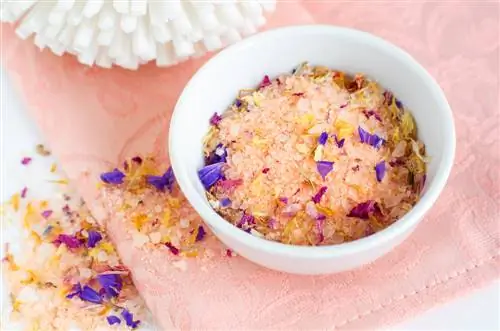
Flowers in flower s alt are a purely visual ingredient
What effect do decorative drugs have?
“Bright colors delight the soul. The eye eats and drinks with you!”
Even though the flowers of medicinal plants such as marigold, chamomile or St. John's wort are often used as decorative drugs, they still have no significant effect in tea blends or salads - the amount used is simply too small. In addition, the petals are used in this context less because of their pharmaceutical effect, but rather because of their pleasing appearance. The bright colors are intended to ensure that tea (for example an otherwise not very tasty medicinal tea) is actually drunk or that the boring green salad is spiced up with splashes of color.
Which plant species and parts can be used as an ornamental drug?
Colorful petals, which can be dried quickly and colorfast, are primarily used as decorative drugs. Of course, you may only use edible plant material and under no circumstances use poisonous plants - so stay away from delphiniums or monkshood, no matter how beautifully they shine!
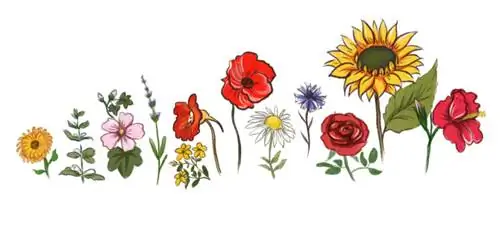
The flowers of these types of flowers are particularly suitable:
- Hibiscus (flowers and fruits)
- St. John's Wort
- Chamomile
- Nasturtium
- Poppies
- Cornflower
- Lavender
- Mallow
- Melissa
- Marigold
- Rose (noble and wild roses, flowers and rose hips)
- Sunflower
Of some flowers you can use not only the fresh or dried flowers, but also the fruits. A good example of this are the rose hips, which often appear on many wild roses in late summer.
Collecting and drying jewelry drugs

The decorative drugs should be unsprayed, edible flowers
When collecting the flowers, make sure that
- Only collect edible flowers
- have determined these beforehand
- If you are unsure, avoid collecting (some poisonous flowers can easily be confused with edible ones, such as chamomile and chamomile)
- only use unsprayed flowers (e.g. not from the edge of the field where the farmer has probably applied weed killer or mineral fertilizer; edges of busy roads are also not good collection places)
Potted plants, such as potted roses, often have a notice stating that these plants are not suitable for consumption. This information is there for a reason, as plants grown industrially in greenhouses are often treated with pesticides - and therefore contain toxins.
You should also avoid collecting rare wild plants in order not to endanger their reproduction and thus protect the stocks. The pretty cornflowers, for example, which used to be found en masse in cornfields, now only grow very rarely. However, you can grow such flowers in pots with little effort from collected or purchased seeds and pick them if necessary.
Only use clean flowers as you should not wash them before drying them. It's best to pick them shortly before they wither and dry them immediately - preferably in a dehydrator or in the oven. The petals you have made can then be stored in a well-sealed container or used straight away.

Frequently asked questions
Can you also use colorful leaves as decorative drugs?
Some plant species have pretty, colorful leaves that are ideal as decorative drugs. But be careful: Even if the targeted leaves are a non-toxic species, the foliage often contains significantly higher concentrations of active ingredients than flower petals. This can be a problem, especially in tea blends. Therefore, it is better to avoid using leaves or needles for this purpose.
What about birch bark, it stays nice and white after drying?
Birch bark contains numerous active ingredients that are used in natural medicine for all kinds of purposes - for example for wound healing. In principle, you can use birch bark as an ornamental drug, but only to a very small extent. Here - as so often - the dose makes the poison.
Tip
Pretty packaged and labeled in a stylish glass jar, tea blends or blossom sugar make a nice souvenir or gift.


